Archive for the ‘Listening Post’ Category
Tuesday, May 25th, 2010
by Editor 20100525.
At the end of April a copy of the “National Parks and Wildlife (Sustainable Tourism) Bill, 2010” came into the possession of the Colong Foundation. This Bill introduces specific tourism provisions into the National Parks and Wildlife Act, 1974, including a long shopping list of development opportunities that would permit fast food joints, supermarkets, wedding reception centres, conference centres and resorts of all sorts.
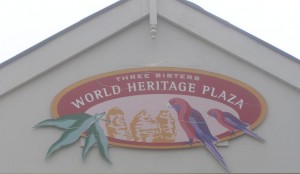
The Colong Foundation sought the advice and assistance of Mr Tim Robertson SC, who in 2004 so admirably defended the Grose Wilderness from exclusive occupation by Fox Studios. Justice Lloyd in his judgment on that case found that the production commercial feature film “Stealth” (about rouge military aircraft), “has nothing to do” with the National Parks and Wildlife Act’s objects or the purpose for reserving land as National Park. The case was thrown out Court, but not until after several local conservationists had been arrested defending wilderness.
If this “Sus. Tourism Bill” is passed, then the legal action to stop “Stealth-type” activities will be virtually impossible and bad developments will sprout up in our precious National Parks.
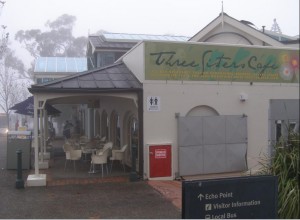
The whole point of these changes is to destroy the nexus between uses of the national park and the conservation purposes for which the park was reserved, and the power of the Court to adjudicate on whether the Minister’s decision accords with those purposes. Under these new laws, it is the Minister, and not the Courts, who will decide whether a use accords with the Park’s purpose.
Mr Robertson advised that the proposed legislation “removes the legal protection of National Parks from uses which damage their ecology and landscapes, by destroying the principle that National Parks can only be used for a purpose which promotes the use of the land as a public park. It provides the legal authority for the privatisation of National Parks by enabling exclusive possession rights to be given for commercial purposes to private interests under the broad rubric of sustainable tourism. Under this rubric, National Parks will be able to be used for general tourist purposes, such as tourist resorts, convention centres, shopping centres, fast food outlets, sporting activities and fun parks, at the discretion of the Minister, even where those uses do not promote the conservation of the Parks.”
The tourist industry grab for land rights over National Parks has to be stopped. Environment groups will be taking the issue to the people at the Penrith by-election and through the media.
Given the Coalition’s stance on Part 3A planning laws, it seems unlikely that the Coalition Parties will support these new park laws. The Shadow Environment Minister, Catherine Cusack wrote to the Nature Conservation Council in November 2009 and advised that she and the then Shadow Tourism Minister, Don Page, “do not support private accommodation facilities inside National Parks.”
The NSW Government should act to strengthen national park laws as they have repeatedly promised to do, not weaken them to facilitate commercial development. National Parks and Wildlife should not be selecting development sites in parks with the aim of offering these sites to the tourism industry in an “investor-ready” form. Our parks should not become profit centres for developers.
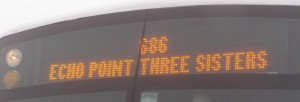
There is no evidence whatsoever to support the notion that private development in national parks will boost the tourism industry or provide extra funds for park management. A stronger nature tourism industry for NSW with more people enjoying the parks is best achieved by encouraging tourism investment in nearby towns where it most benefits regional communities.
With our rapidly growing population, the integrity and protection of our parks is more important now than ever before.
How is it that the Coalition Parties seems capable of grasping these ideas, while the NSW Labor Government remains unresponsive?
Keith Muir, Director, Colong Foundation for Wilderness
Sydney, Australia
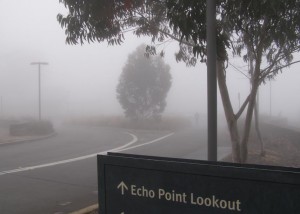
© The Habitat Advocate Public Domain
Friday, May 21st, 2010
by Editor 20100521.
a poem….

– – –
A Scribbly Gum here I stand
My species iconic, proud, but now condemned
They cast the red die on my girth, the red mark of death
So numbingly final
Glazed thoughts I can only muster
My roots here so ancient, means nothing to them
Scribblies flourished this land since Gondwana dawn
Pervading this old stone country high and deep
– – –
Once a wild place
A natural order, virgin and vast
Of times past, these primitive escarpments hosted wilderness
When old men Scribby Gums knew no saw
– – –
Came the getters, the settlers, the saws
For conquest, for progress, for their plot with a view
Wilderness they castrate, deemed it ‘battleaxe’
Ridges and valleys to the slaughter
Slaughter they sanitized, deemed it ‘clearing’
– – –
Some saw the wrong
Some good laws got through
Some Scribblies saved from slaughter
So why not protect me now?
– – –
Heritage denied me just trees away
Relegated from their Listing, on the fringe
Zoned a resource, a fuel, a hazard
Decisions cast from the Hill, to serve those from distant hills
Now they reason I block their view, I block their way
They cast the red die on my girth, the red mark of death
– – –
I’ll miss the rain most, the best time
When nature regains control
When the cloud drifts in, when it feels wild again
And dark rumblings roam and flare above
Dousing me in soaking cloud
Wild escarpment days
– – –
Motors approach. They come for me
Only a bus, it slows, they take photos, it groans away
Quiet again
– – –
Below the cloud, a piercing sunset glows my bark gold
Down the valley, the bush blanket surges
A breeze rising up the escarpment, fans me fresh
Around me branches sway, then settle, restful
Still again,
Quiet again
– – –
Soon they come
They cast the red die on my girth, the red mark of death
My death an extinction wedge
When they scatter my woodchips on their plot
Will they know I was once a Scribbly Gum – free and wild?
Their photos will torment of treasure lost
This wild country locked in myth
Motors approach
A saw starts
No!
.
by Editor, 23-Oct-04.
© The Habitat Advocate All Rights Reserved
Saturday, May 15th, 2010
by Gorillaman 20200515.
In and upon my travels throughout our Australian continent, its shorelines and its interiors, I see the impacts of international corporatized exploitations. Some would argue that this corporate exploitive activity is a necessary component to cultivate Australia’s ongoing economy, though I myself tend to hold a far differing opinion.
This land of Australia lived quite well in our days not long past, indeed without such fervent corporates ever hunting for multi-million dollar profits so to appease the gods of corporate gluttonous predatory plunder upon our Australia.
I now question the manner in which for instance, the Howard Federal Liberal government of recent time, soon began the sell-off of such great amounts of our eternal free-flowing river waters, to whosoever chose to purchase same. Never considered by this government here, were the resultant out-takes of such huge amounts of our once proudly valued and esteemed freely-flowing and constant river waters.
There was found to be a ready market for such sales, even to be quickly sought by former government ministers with arranged corporate inclined and intended operatives, then to amass all that could be purchased and or promised, for such purposes upon open dry-lands not generally visited by the soon to be created abundancy of broad acre irrigation farming initiatives. Never considered by this government were the ensuing reductions in their effect upon our seasonal wetlands and swamp-lands, nor to the many river dependant towns and communities and so on, including the small privately owned food producing farmers downstream of such massive water out-take excesses.
The most exploited of our river systems are those that fed into and became one of the major sources of water that feeds into the Murray-Darling River Systems.
Since time immemorable these river systems above-mentioned, were ever reliant upon such as the seasonal Northern Queensland flooding rains, then of the Vic/NSW winter highland melting-snows, that seasonally would ultimately feed into the many downstream outback-area lakes, billabongs, creek systems et al, and also supplied such other particular flora and fauna dependant realms and natural water holdings. So another export commodity has arrived from the mighty corporate America that soon fails us here in our Australia.
An easily accessible internet search today, will soon reveal the huge reduction of which once were previously, the eternal annual river water volumes and flow-rates?
To compare the present situation to what we once held nationally as in important primary source of water for the Eastern States of Australia, as now now measured against the resulting huge corporate inland farming operations, has now departed us seemingly gone into the forever….
The Angry Gorillaman.
© Gorillaman All Rights Reserved
Wednesday, May 12th, 2010
by Editor 20100512.
Yesterday, The NSW Department of Environment, Climate Change and Water (DECCW) within its Parks and Wildlife Group set fire to over 2500 hectares of remote wilderness in the Greater Blue Mountains World Heritage Area.
This deliberate burning was carried out in the name of ‘hazard reduction’ – in order to reduce the available ‘fuel’ (native vegetation) for potential future wildfires or bush arson.
Under the orders of the Blue Mountains regional manager, Geoff Luscombe, this deliberate burning was started around Massif Ridge some 12 kilometres south of the town of Woodford in wild inaccessible forested area of the World Heritage Area.
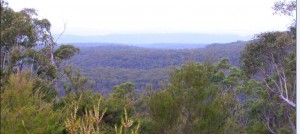
Aerial incendiary from a helicopter was used to ignite the forest vegetation floor and incinerate all ground cover and vegetation habitat across a large contiguous area, crossing over creeks and gullies. Fanned by a light southwesterly, the fire incinerated all native ground cover up to the tree canopy for a distance of 5 km into the Blue Labyrinth up to The Oaks Fire Trail.
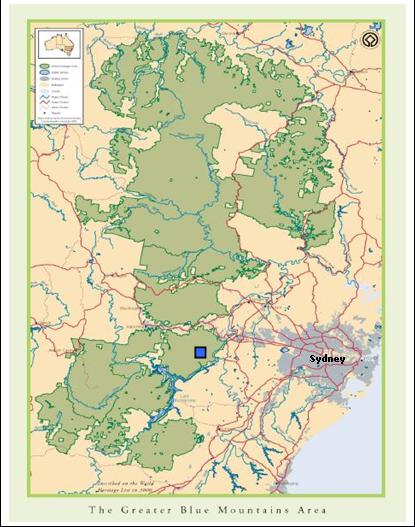
Luscombe told the media that:
“this late warm weather has created a window of opportunity for us to get this important burn done and we’re taking full advantage. “The 2507-hectare burn will be conducted south of the Woodford-Oaks fire trail, and as a result the trail will be closed to mountain bikers and bushwalkers for the duration of the burn – approximately four to five days….“This burn is aimed at reducing fuel loads to help protect properties and assets in the region.” [1]
Luscombe ignores the massive natural asset in the region is indeed the Greater Blue Mountains World Heritage Area he is setting fire to. The scale of the forested area affected equates to a 5km x 5km area, or 25km2 – an area about 1/3 the size of Lake Burragorang. Yet, the official Rural Fire Service website typically and misleadingly shows the burn area size as ‘zero’ hectares.[2]
| Incident Name |
Alert Level |
Location |
Council Area |
Status |
Type |
Size (Ha) |
Agency |
Last Updated |
| Massif Ridge Hazard Reduction |
Advice |
Massif Ridge Hazard Reduction |
Blue Mountains |
Under Control |
Other |
0 |
Dept Environment & Conservation |
|
The scale of the combined burns was also evident from the blanket of smoke smothering the entire Sydney basin and Cumberland Plain yesterday. This is shown in the following photo from the Sydney Morning Herald.
 Smoke Haze over Sydney Smoke Haze over Sydney
© Photo by Sydney Morning Herald
Broadscale Burning Policy
The purpose of bush fire-fighting is to put out bushfires and in the case of wildfires to limit their spread and impact.
However, DECCW’s bush burning policy is advocating exactly the opposite. This year up until 19th April 2010, DECCW boasts that it has performed 193 prescribed burns across NSW ‘treating’ more than 56,000 hectares. Last year it manage 168 prescribed burns ‘treating’ a similar 59,202 hectares. It claims this represents one of the biggest ever deliberate burning programs in National Parks’ history.[3] This equates to an area of national parks being burned every year approximating ¼ the area of the Australian Capital Territory; and this is on top of wildfire and bush arson.
Every year DECCW contracts helicopters and indiscriminately tosses out incendiary devices over wilderness forests. Thousands of hectares are burnt in a free-for-all and thousands of native animals are roasted. Thank crikey these State-sanctioned arsonists aren’t given access to napalm.
DECCW labels its deliberate burning of native vegetation with euphemisms like ‘hazard reduction’, ‘controlled burning’, ‘prescribed burning’, ‘cool burning’ and even ‘ecological burning’. It claims burning vast areas of vegetation somehow ‘assists’ biodiversity, justified on the simplistic premise some species of flora are fire tolerant and grow back. DECCW claims that its burning is essential to manage biodiversity to maintain the reproductive viability of a species or a community of species. DECCW’s ‘eco-logic’ is that since the bush grows back after fire it must be a good impact and therefore good for biodiversity.
DECCW terms areas of national parks targeted for such broadscale burns as ‘Strategic Fire Advantage Zones’ or SFAZs. DECCW justifies charcoaling a massive contiguous landscape as ‘assisting’ biodiversity.
Bollocks!
Luscombe himself has admitted that given the few reliable days a year it is considered safe to burn, DECCW engages in broadscale burning simply a matter of operational convenience.
Mosaic burning is too labour intensive and the typically inaccessible gullied terrain and thick forested vegetation of many national parks makes mosaic burning impracticable and too costly. Be clear; it is all about operational efficiency, not ecological biodiversity.
Last March, DECCW set fire to 2,200 hectares of native habitat in the Blue Mountains in remote wilderness in Kanangra-Boyd National Park near Jenolan Caves.[4] In April 2008, DECCW dropped aerial incendiaries in remote wilderness just to the north along the Krungle Bungle Range.
Like the Rural Fire Service, DECCW is denied serious public resources to detect and suppress wildfires, so it demonises and burns the bush, so destroying the natural asset it is charged to protect and conserve.
DECCW has descended into ecological bastardry, imposing a regime of arson fundamentalism upon nature. This is an unprincipled ‘bush-phobic’ culture.
Broadscale burning is sterilised ecosystems and driving species extinction
The Sydney Morning Herald reported ‘a rogue breeze drove smoke from hazard reduction burning in the Blue Mountains down to street level.’[5] It is more the rogue management of the National Parks Service that misguidedly thinks burning vast swathes of bush at once is good for biodiversity. This demonstrates the wanton disregard for native fauna and flora habitat and disrespect for Aboriginal cultural heritage.
Large contiguous areas of tens of thousands of hectares severely compromising flora and fauna conservation, potentially causing permanent ecological change and loss of species. In the process, DECCW is destroying natural and cultural heritage values of National Parks, causing long-term ecological damage and driving native species extinction.
Collectively, the forested area of the Blue Labyrinth now will lay sterilised of the naturally rich biodiversity of flora and fauna. When the rains come the exposed tops soil will wash away. Watercourses will choke with sediment. The thin fragile soils will change and so change the ability of the soil to replace the complex floristic structure. Only plants that are fire tolerant will recover. Only plants that are hardy to poor soils will recover. There will be less floristic diversity, not more.
Ground-dwelling mammals will have had their burrows, dens, nests, shelters burned and destroyed by the fires. Food sources for spotted-tailed quolls, rufous betongs and wombats will have gone. The undergrowth will have gone leaving a bare open charred landscape. Such a disturbed open landscape benefits feral pedators like cats and foxes and wild dogs. Complex and dense ground vegetation reduces the impacts of predators. But the post-fire regrowth takes many months and creates a simple shrub and herb layer. This allows maximum freedom of movement for cats and foxes, and provides minimum concealment for their prey.[6]
Territorial mammals and raptors do not simply relocate. They remain in their territory and have to compete with these feral predators. Many die. As top order predators like quolls and owls die, this alters the food chain and contributes to local extinctions.
Such broadscale deliberate burning of forest habitat is a threatening process driving Australia’s mammalian extinctions.
Australia has the worst record of mammalian extinctions of any country on Earth, with nearly 50% of its native mammals becoming extinct in the past 200 years.[7]
Australian native fire tolerant fauna (‘pyrophytes’) like most Eucalyptus, Acacia, Proteaceae, Xanthorrhoeaceae and many native ferns and grasses recover quickly after bush fire. However not all species of Eucalypt are fire tolerant (or ‘pyrophobes’) as commonly assumed. Eucalyptus parvula, Eucalyptus saxatilis and Eucalyptus tetrapleura are not fire tolerant. Also, some species of Acacia are not fire tolerant such as Acacia georgensis and Acacia chrysoticha.
Flora diversity varies with soils, aspect, topography and other factors. The Blue Labyrinth is characterised by a labyrinth of ridges and gullies, hence its name. Flora along riparian zones is generally wetter and not as well adapted to fire as ridgeline flora. Yet DECCW’s one-size-fits-all blanket broadscale burning of 2500 hectares up hill and own dale completely disregards the complex biodiversity variations between the gullies and ridgelines. What its blanket burning yesterday has done to the Blue Labyrinth, however, is indeed to have encouraged a consistent simpler form of regrowth vegetation – that is, less biodiversity.
Obviously no animal species is fire tolerant. The Blue Mountains provides habitat to many native mammals including Yellow-bellied Gliders, Koalas, Feathertail Gliders, Eastern Pygmy-possums, Brush-tailed Rock-wallabies, Spotted-tailed Quolls and Antechinus. What happens to these mammals when caught in burn-offs? Where are the native zoological surveys before and after reports for each of these burns?
Native mammals and raptor birds are territorial and do not relocate and typically perish. Broadscale unnatural fire regimes produce unnaturally high biomass, but not true biodiversity.
DECCW’s policy has bad biased biodiversity and fire ecology science to support its simplistic economic approach to bushfire management. DECCW has lost its way as a custodian of protected areas. It is now charged with priorities for exploitative tourism.
Land clearing and frequent broadscale bushfire continue to put many unique species of Australian wildlife at risk. Over the last two hundred years many species of plants and animals have become extinct. DECCW as trusted custodian of NSW’s natural wild areas and in increasing its frequent broadscale burning is possible the greatest contributor to species extinctions across NSW.
Broadscale Burning Justifications Lack Scientific Merit
The DECCW is charged with custodial responsibility for environmental conservation and protection of the national parks and reserves under its control. DECCW is the lead agency responsible for environmental management of the Greater Blue Mountains World Heritage Area (GBMWHA). The GBMWHA Strategic Plan provides management principles and a framework for the integrated management, protection, interpretation and monitoring of the heritage values.
Two key strategic objectives for DECCW management of the GBMWHA is to ‘identify, protect, conserve… the World Heritage values of the GBMWHA’ and to reduce the potential for major impacts to adversely affect the integrity of the GBMWHA. Where there is doubt about the potential impacts of an action on World Heritage values
the ‘precautionary principle’ shall be applied. Under the ‘precautionary principle’:
“where there are threats of serious or irreversible damage, lack of full scientific certainty shall not be used as a reason for postponing cost-effective measures to prevent environmental degradation”.[8]
Aerial incendiary to indiscriminately burn 2500 hectares of remote wilderness is clearly an impact causing serious and likely irreversible damage to important faunal habitat. Such bush fore management practice on a large congruous scale clearly lacks scientific certainty.
In a CSIRO Journal of Wildlife Research, Michael Clarke, associate professor in the Department of Zoology at La Trobe University says it is reasonable for land management agencies to try to limit the negative effects of large fires and to be sure they do not lead to irreversible damage to native wildlife and habitat.
Much hazard reduction is performed to create a false sense of security rather than to reduce fire risks, and the effect on wildlife is virtually unknown. The sooner we acknowledge this the sooner we can get on with the job of working out whether there is anything we can do to manage fires better. We need to know whether hazard reduction can be done without sending our wildlife down a path of firestick extinctions.[9]
Clarke has called for the massive burn-offs to be scrutinised much more closely.
“In this age of global warming, governments and the public need to be engaged in a more sophisticated discussion about the complexities of coping with fire in Australian landscapes.”
He wants ecological data about burns collected as routinely as rainfall data is gathered by the agricultural industry. Without it, hazard reduction burning is flying scientifically blind and poses a dangerous threat to wildlife.
“To attempt to operate without proper data on the effect of bushfires should be as unthinkable as a farmer planting a crop without reference to the rain gauge.”
In the coming decades, native plants and animals will face enough problems – most significantly from human-induced climate chaos – without having to dodge armies of public servants armed with lighters. Guesswork and winter smoke are not enough to protect our towns and assets now, and the risk of bushfires increases with the rise in carbon dioxide.[10]
The incinerating of 2500 hectares of remote bushland in the Blue Labyrinth yesterday was not to protect the houses and properties of Woodford some kilometres away.
Such broadscale deliberate lighting of thousands of congruous hectares of native forest habitat is not protecting houses. This is not clearing dead vegetation around properties. It was fuelled by an unquestioned vandalistic compulsion to burn any bushland that has not been burnt, simply for that reason and that reason alone. The bushfire management call it strategic. But it is a cultural bush-phobia – a fear and lack of respect for the natural landscape. It harks to early Australian colonial mindset that feared the bush to the extent that one had to tame it else invite wildfire Armageddon.
Contempt for Aboriginal Archaeology in the Blue Labyrinth
The Blue Labyrinth is a rugged natural region of forested hills and gullies a few kilometres south of the central Blue Mountains village of Woodford. It is an area of ancient Aboriginal culture. There are caves in the area displaying Aboriginal rock art dating back tens of thousands of years.
In February 2006, DECCW’s Aboriginal Heritage Information Management System (AHIMS) collated an official record of indigenous archaeological sites across the Greater Blue Mountains World Heritage Area. It listed some 850 discrete archaeological sites and 973 features in the GBMWHA, representative of past indigenous activities that remain in the landscape and are essentially the “Aboriginal archaeological record”.
An Assessment of the Aboriginal Cultural Heritage Values of the Greater Blue Mountains World Heritage Area by the Blue Mountains World Heritage Institute (BMWHI) in 2007 highlights the important Aboriginal cultural heritage values of the area. Recent discovery and documentation of numerous Aboriginal archaeological sites and features in the Blue Labyrinth include shelters, shelter walls, rock platforms marked with imagery and grooves. These have largely been preserved because of the rugged and inaccessible terrain. The GBMWA remains highly significant for the many Aboriginal communities associated with it and there is a renewed and re-invigorated interest in the Area’s cultural heritage.”[11]
In December 2006, leading world rock art expert Dr. Jean Clottes to dozens of sites across the GBMWHA and the central coast. Clottes was recently appointed to UNESCO to advise the institution on the creation of a World Heritage Rock Art List.
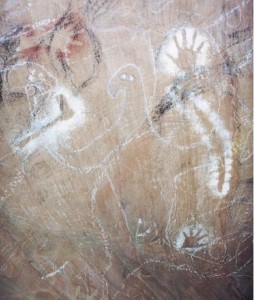
The main eagle depiction at Eagle’s Reach,
acknowledged as extremely rare by the Aboriginal community
© Photo by Paul S.C. Taçon
He was so impressed with the GBMWHA rock art sites, and associated contemporary Gundungurra, Darug, Wiradjuri and Darkinjing stories that he considers the Area to have world Heritage significance. Indeed, it was the living connections to the sites and larger landscapes that most impressed him.[12] Rock Art at Bora Cave in the Blue Labyrinth is an example of important cultural connections of the local Gundungurra and Darug to the area.
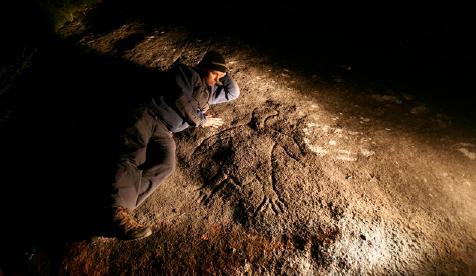
Life-size eagle engraving, Gallery Rock
© Photo by Tristram Miller
Through the Mapping Country research in the Blue Labyrinth area of the Blue Mountains National Park, hundreds of Aboriginal cultural places were recorded. The BMHWI highlighted in its 2007 report the risk of damage by natural environmental processes and exposure to modern human activities. Particularly highlighted was the risk posed by an increase in the frequency and intensity of wildfires and… and efforts to control fires can damage or destroy rock art sites. By locating and mapping sites they can be catered to as part of fire management strategies.[13]
Yet, it would appear from anecdotal evidence that DECCW failed to contact the traditional Aboriginal owners of this land to inform them of the planned burning. It is likely with such indiscriminate broadscale burning that some of the cultural sites may have been irreparable damaged.
What happened to Attic Cave, Dadder Cave and the Aboriginal archaeology between the Massif and The Blue Labyrinth? Was it burnt out and destroyed by DECCW’s needless incineration?
What happened to the wildlife and wildlife habitat? DECCW these days is more a patsy of NSW Labor right wing economic rationalism focusing on tourism revenues, than it is on its core ecological wildlife conservation raison d’etre .
References:
[1] ‘Smokin’: Sydney cloaked by burn-off’, by Paul Tatnell, Sydney Morning Herald, 11th May 2010, http://www.smh.com.au/environment/smokin-sydney-cloaked-by-burnoff-20100511-usg7.html
[2] NSW Rural Fire Service, http://www.rfs.nsw.gov.au/dsp_content.cfm?cat_id=683
[3] DECCW, Nature Conservation > Fire > Managing fire in NSW national parks > Preparation and hazard reduction, http://www.environment.nsw.gov.au/fire/prepandhazreduction.htm
[4] ‘Hazard Reduction – DECC playing with matches in Kanangra-Boyd NP’, 13th March 2009, http://candobetter.org/node/1142
[5] ‘The big smoke finally enjoys a little light relief’, by Ben Cubby, Environment Editor, Sydney Morning Herald, 12th May 2010, page 1, http://www.smh.com.au/environment/the-big-smoke-finally-enjoys-a-little-light-relief-20100511-uuum.html
[6] Chris Johnson, ‘Australia’s Mammal Extinctions: A 50,000 year history’, Cambridge University Press, Melbourne, p.226
[7] Tasmanian Department of Primary Industries, Parks, Water and Environment, http://www.dpiw.tas.gov.au/inter.nsf/WebPages/BHAN-53777B
[8] United Nations, General Assembly, ‘Report of the United Nations Conference on Environment and Development, Rio de Janeiro, 3-14 June 1992, Annex I: ‘Rio Declaration’, http://www.un.org/documents/ga/conf151/aconf15126-1annex1.htm
[9] ‘The dangers of fighting fire with fire’, by James Woodford, 8th September 2008,in Sydney Morning Herald, http://www.smh.com.au/news/opinion/the-dangers-of-fighting-fire-with-fire/2008/09/07/1220725850216.html
[10] ‘The dangers of fighting fire with fire’, by James Woodford, 8th September 2008,in Sydney Morning Herald, http://www.smh.com.au/news/opinion/the-dangers-of-fighting-fire-with-fire/2008/09/07/1220725850216.html
[11] Blue Mountains World Heritage Institute, 2007, ‘Assessment of the Aboriginal Cultural Heritage Values of the Greater Blue Mountains World Heritage Area’, p.10, http://www.bmwhi.org.au/docs/Assessment%20of%20Aboriginal%20Cultural%20Heritage%20Values.pdf
[12] Blue Mountains World Heritage Institute, 2007, ‘Assessment of the Aboriginal Cultural Heritage Values of the Greater Blue Mountains World Heritage Area’, p.10, http://www.bmwhi.org.au/docs/Assessment%20of%20Aboriginal%20Cultural%20Heritage%20Values.pdf p.26
[13] Blue Mountains World Heritage Institute, 2007, ‘Assessment of the Aboriginal Cultural Heritage Values of the Greater Blue Mountains World Heritage Area’, p.10, http://www.bmwhi.org.au/docs/Assessment%20of%20Aboriginal%20Cultural%20Heritage%20Values.pdf p.36
© The Habitat Advocate Public Domain
Tags: aboriginal archaeology, biodiversity, blue labyrinth, Blue Mountains, bush fire, Geoff Luscombe, hazard reduction, mammalian extinctions, massif ridge, prescribed burning, threatening process, Woodford-Oaks fire trail
Posted in Blue Mountains (AU), Threats from Bushfire | No Comments »
Add this post to Del.icio.us - Digg
Wednesday, March 31st, 2010
by Editor 2010330.
—————————————————————————-
Victorian Government’s VicForests is attempting to log old growth forests at Brown Mountain in East Gippsland, despite Brown Mountain being confirmed habitat for threatened and vulnerable wildlife. Local not-for-profit environment group Environment East Gippsland has commenced proceedings against VicForests in the Supreme Court of Victoria asking the Court for a permanent injunction to stop VicForests from logging Brown Mountain.
Reports:
(most recent at top)
Brown Mountain Landmark Court Case [Melbourne Supreme Court, 23-25 March 2010]
Court case finishes – summary of the final 3 days.
Quoted Source: Environment East Gippsland 20100330, http://www.eastgippsland.net.au/
‘The final days of summing up both VicForests’ and EEG’s arguments were heard in the Melbourne Supreme Court on Tuesday, Wednesday and Thursday (23rd-25th March). These were the last submissions presented to Justice Osborn who heard the 17 day trial that started on the 1st March.
‘In summary – both sides presented their condensed arguments from the past 3 weeks. Early in the case, the economic claims were not allowed as VF had not made any allegations in its defence about economic impact, and there was only summary evidence supplied by VF, without details. The arguments focused on the laws covering protection of threatened species and how VF did or didn’t abide by them. Justice Osborn has reserved his decision . Our legal team have said he could hand this down in a month or two or three … Despite some fairly revealing and insightful evidence being given and some quite startling information to come out of cross examination of witnesses, the decision will be looking at the complexities of the laws governing forests and wildlife management.
‘A support team of about 45 people attended the Melbourne start of the case to show that there was widespread interest in Brown Mountain (see pics). Thanks everyone who came along and who sat through the proceedings.
1st Day (Tues) – the defence (VicForests) lawyers had the stage on day 1 and delivered their case.
‘To those who hadn’t heard the facts, arguments and cross examinations of the previous 3 weeks, it could have sounded fairly reasonable and even worrying. Read our responses to their arguments below. VF lawyers’ arguments consisted of the following:
- EEG didn’t have standing to take the case to court as we are too small a group, don’t have a special interest in Brown Mountain, only an emotional or intellectual interest. The fact that we didn’t apply to be on the local Shire environment committee, and the claim that we didn’t take part in the Nat Estate study on 1990 – (but we actually did) and various other arguments were used to attempt to argue we shouldn’t be able to sue VicForests.
- It was DSE that should have looked out for threatened species, not VicForests. VF can’t change zonings.
- The Potoroo wasn’t ‘detected’ within the meaning of the action statement (FFG Act) – although the animals and the sites were confirmed, the full two weeks of footage was withheld by EEG (under instruction from our lawyers) until late 2009 – making the authorities suspicious of possible tampering and was the reason given by VF for not protecting the area.
- Language in the FFG Act and Sustainable Forests (Timber) Act, is not enforceable.
- VF noted that the Forest Management Plan was out of date (ended in 2006), which generated much discussion. Justice Osborn pointed out that if it was no longer applicable, then all logging in EG was illegal as the FM Plan is needed before forest can be logged. That point was then quickly resolved.
- The Precautionary Principle, which was a major argument in the whole case. It was first claimed by VF not to give rise to any legally enforceable obligation against it, and even if it did, VF claimed it had observed the PP even if it wasn’t thought to be regarded as enough precaution.
- VF claim Potoroo wasn’t ‘detected’ to their or DSE’s satisfaction,
- On Quolls – there are 75 already protected in EG and that was enough,
- For the new species of crayfish – it’s still being named and so doesn’t have a prescription for protection and the 100 metre buffer around the creek will protect it
- Sooty and Powerful Owls – only dusk calls detected but no confirmed nesting or roosting sites so no need to protect. Plus there are enough Sooty Owls Management Areas and Powerful Owl Management Areas, despite some evidence from DSE suggesting the protection zone targets had not been reached.
- Giant Burrowing Frogs – even if it is high quality and likely habitat, none have yet been detected.
- Hollow Bearing Trees – logging prescriptions are claimed to look after them.
- Gliders are there in high numbers, yes – but it’s not for VF to protect them and 100 mts along creek should do anyway.
- The Precautionary Principle requires caution, but not total infallibility. Actions to express adherence to the PP can be many. VF argued that a 100 metre buffer along the creek was caution enough for all the species.
2nd day of summing up (Wed) –EEG, the plaintiff’s case was presented.
Debbie Mortimer SC argued that:
- ‘The standards and conditions in the FFG Act Action Statements, Forest Management Plan and the Code of Forest Practices hasn’t been and can’t be complied with by VicForests.
- VicForests was the “agent of harm” about to begin clearfelling when we applied for the first injunction, and VF was as obliged to adhere to the law for threatened wildlife as was DSE.
- VF don’t need to have DSE declare a conservation zone for VF to adhere to the law or decide not to log.
- The Allocation Order (giving forests to VicForests from DSE), Timber Release Plan and the Code (for logging) all mention adhering to the Forest Management Plan.
- The issue of whether EEG has legal standing to bring the case to court was argued well for showing we did have standing. It had not been objected to by VF strongly before we embarked on the 17 day trial.
- If various surveys had not have been carried out (owls, Gliders, Crayfish and Potoroos), the court case would not have commenced. Surveys show a genuine interest.
- Obligation on VF are mandatory – they don’t allow them to ‘duck and weave’ around these obligations.
- The main law is the Flora and Fauna Guarantee Act – it deals directly with Threatened Species, and binds the state/crown to protect endangered wildlife. The FM Plan and the Code both refer to it.
- Forests are a community property. Managed for common good into future. DSE’s position in the evidence given by Lee Meizis was that the Timber Release Plan gave ownership of forests to VF to exploit, but with the right to exploit comes responsibilities for conservation.
- FFG Act has strong ‘must do’ language and is imposed on government authorities. Important objectives of FFGA disregarded by VF. Action Statements within the FFGA are enforceable.
- Debbie Mortimer said “In every way, VicForests pushed away from its conservation duties” to benefit its access to forests for logging.
- VF is not abiding by the law by merely reading the Action Statements.
- Logging high quality Quoll habitat is endangering the animal’s survival. At odds with the Precautionary Principle because this species is only found at a functional level in East Gippsland now.
- Sustainable Forests (Timber) Act directly forced VF to adhere to the Code. Allocation Order also states VF MUST comply with CFP, PP, AS and FMP.
- Not complying with the Code was a breach. Acts refer to the Code being adhered to.
- VF must consider advice from relevant experts in Flora and Fauna. The advice of these internal DSE experts were ‘completely sidelined’ during the process that lead to the decision to clearfell Brown Mountain. It was also claimed that the Minister was not given important information on these species.
- The 100 mt buffer offered by VF would not protect the Gliders, Quoll, owls, Potoroo and Large Brown Tree Frog and was unknown if it would adequately protect the Giant Burrowing Frog, Brown Mt Crayfish and Square-tailed Kite. Leaving additional large trees while logging and burning the remainder would be unlikely to protect the habitat values of hollow bearing trees (85 out of 207 was all that survived the logged and burnt coupe across the creek in April 2009).
- The guideline to protect 100 ha for rich populations of gliders is self-regulating and doesn’t need major fuss – just needs to be mapped and complied with.
- Justice Osborn discussed decent reserve designs and ‘whacking in’ some reserve along the creek.
- The oft-cited ‘risk-weighted consequences’ of the precautionary principle the VF lawyers used daily, does not mention social or economic ‘balance’ and in context is only about conservation risks and consequences.
- We are dealing with some species in a demonstrable state of decline. Failure to halt damage is serious. There is lack of scientific certainty as there is no research or info on impact of logging.
- New reserves mean nothing unless we assess the quality and type of the habitat, logging history etc.
- BHP was used as an example of a company which must employ specialist ecologists/biologists if it plans to carry out potentially damaging work. VF either needs to employ biodiversity staff, or get in consultants to survey and advise forest planning.
- Potoroo detections 100% authentic – no questioning by VF of witnesses – fully accepted, yet despite 3 verified detections, VF made no attempt to consult with DSE biologists or protect 50 ha for each as stated in the FFGA.
- DSE set up its own ‘rules’ outside of existing legislation.
- DM asked for full injunction to logging.
Day 3 – Thursday – response from Defendant (VF)
- ‘Having to abide by the SFT Act could mean that every logger, truckie, contractor, roading operator must comply with these laws as well. Does that mean every worker has to set up a biodiversity unit and consult biologists?
- Argues again, it’s all DSE’s responsibility.
- Argues that the words for Greater Glider protection in the FMP says “approximately 100 ha” is unenforceable – how much is ‘approximately’?
- VicForests Lawyers couldn’t find any expert biologists to speak for them. They tried.
- Not being given the entire potoroo footage was the whole problem.
- The 400 ha reserve to the (drier, steeper) west is a benefit for all the species.
- Crays were found in the creek next to a previously logged forest so therefore they can survive OK.
- Potoroo no 2 (on camera) wasn’t used in original evidence (it was actually discovered after writ was served but this was overlooked by VF lawyers).
- The hair tube evidence of the Potoroo near proposed coupe 19 didn’t come with a copy of the note when it was sent off for analysis – so how do we know where it really was?
This ended the long trial for the wildlife of Brown Mountain. We await Justice Osborn’s final decision …”
Court Case:
‘Environment East Gippsland Inc v VicForests [2010] VSC 53 (25 February 2010)’
(Supreme Court of Victoria)
SOURCE: http://www.austlii.edu.au/au/cases/vic/VSC/2010/53.html
|
JUDGE:
|
|
|
WHERE HELD:
|
Melbourne
|
|
DATE OF HEARING:
|
|
|
DATE OF RULING:
|
|
|
CASE MAY BE CITED AS:
|
Environment East Gippsland Inc v VicForests (Ruling No 2) |
|
|
|
Revised 4 March 2010
|
HIS HONOUR:
1 ‘The background to this proceeding is stated in the decision of his Honour Justice J Forrest made last year, and granting injunctive relief to the plaintiff. The injunction restrains logging and associated works within coupes located at Brown Mountain in East Gippsland. The underlying basis on which the plaintiff seeks relief in the proceeding, and upon which it sought and obtained injunctions is that the coupes in issue have such conservation significance that logging of them would be unlawful, having regard to applicable legislative and governmental controls which seek to protect such significance.
2 The plaintiff by summons dated 23 February 2010 now seeks leave to amend its statement of claim in accordance with a form of amendment appended to the summons. That application is resisted by the defendant insofar as the amendments raise allegations of the presence of the three animal species within the relevant area, which have not previously formed the basis of the plaintiff’s claim. The matter is fixed for trial at Sale commencing on Monday next, and has been the subject of a framework of pre-trial directions intended to ensure that it would be ready to proceed at that date, and to ensure that the defendant was accorded procedural fairness. The defendant wishes the matter to proceed next Monday whether or not the amendments are permitted, because any delay will result in the continuation of the injunction which it submits is causing it continuing economic loss and prejudice. The plaintiff contends that the amendments can be made at this very late stage without the necessity of any adjournment of the trial, and that the trial can proceed with adequate procedural fairness from the defendant’s point of view. I accept the relevant principles relating to the application were restated by the High Court in the case of Aon Risk Services Australia Limited v ANU.
3 For present purposes it is sufficient to repeat what was said in the judgment of the plurality: An application for leave to amend a pleading should not be approached on the basis that a party is entitled to raise an arguable claim, subject to payment of costs by way of compensation. There is no such entitlement. All matters relevant to the exercise of the power to permit amendment should be weighed. The fact of substantial delay and wasted costs, the concerns of case management, will assume importance on an application for leave to amend.
4 The underlying objective of the court must of course be to achieve a just resolution of the dispute between the parties. That notion in a case such as the present extends to the objective insofar as it is reasonably possible of ensuring that justice is seen to be done with respect to the real matters in dispute between the parties. In the present, case I accept that the amendments in issue arise out of circumstances to which the plaintiff was alerted by advice given to the plaintiff by a series of expert witnesses who have carried out ongoing site investigations for the purposes of preparing reports for the trial. If the amendments are refused, and this evidence is excluded, the evidence will not be the best evidence available as at the date of trial of the conservation significance of the land.
5 In my view, such a refusal would not only on the face of it prejudice the plaintiff’s case, but also necessarily detract from the credibility of the evidentiary basis on which the Court proceeds to determine the matter. And I am further of the view that this issue is of particular significance in the present case because it raises issues of the public interest both from the point of view of the position of the plaintiff and the defendant.
6 Accordingly the amendments should be allowed in the absence of prejudice to the defendant, which can be said to outweigh the prima facie desirability of the amendment. The notion of prejudice is to be approached broadly as the decision of Aon makes clear. In the present case, it is first submitted on behalf of the defendant that there has been delay on the part of the plaintiff which should preclude the granting of any indulgence to it. In particular, reference is made to the identification of a new species of crayfish in a report dated 7 December 2009 prepared by Dr McCormack.
7 The substance of this report was not the subject of advice to the defendant’s solicitor until 18 February this year. I accept the delay was regrettable and contrary to the intention and indeed the spirit of the directions made previously by the court in order to put the case in a proper position for trial. Nevertheless, the relevant expert retained by the defendant has now had the opportunity to consider and respond to the report in issue, and I am not persuaded that delay with respect to this aspect of the matter justifies refusal of the amendment.
8 Next it is submitted the defendant will suffer significant procedural prejudice if the amendments are allowed. It is not submitted that repleading the defence will occasion undue difficulty. And on the face of it, the probability is that the defence will be repleaded in parallel terms to the pleas which have previously been made in relation to other species which the plaintiff alleges are present in the relevant area.
9 The problem from the defendant’s point of view is in respect of obtaining expert advice responsive to the material now put forward in respect of the alleged presence of bird and frog species only recently identified as relevant on behalf of the plaintiff. This difficulty is exacerbated due to personal circumstances affecting the expert whom the defendant has retained in this matter, and proposes to call to give evidence.
10 Although the question is, I accept, finely balanced, I have come to the view that the procedural prejudice in issue can be significantly ameliorated and it may reasonably be hoped avoided, if an appropriate basket of directions is made by the Court. First, I would not fix a time for the filing and service of an amended defence, but simply direct that such an amended defence be filed and served as soon as is reasonably practicable.
11 Secondly, I would direct that save with the consent of the defendant, the plaintiff call all evidence other than that relating to the matters of fact alleged in the amendments prior to calling evidence concerning such matters. Thirdly, I would direct that Professor Ferguson be at liberty to respond to evidence relating to such matters by viva voce evidence with no written notice of the substance of such response. And fourthly, I would specifically direct that the defendant be at liberty to apply for further directions relating to the evidence concerning such matters.
12 It seems to me that if these directions are made, then having regard to the pleadings as a whole as they currently stand and the expert evidence foreshadowed in the documents that have been filed with the Court, a fair trial should be reasonably possible. I should further record that during the course of argument I indicated to counsel for the defendant that the court would adopt a flexible approach to the giving of Professor Ferguson’s evidence if that should become necessary.
13 In addition to the procedural concerns which the defendant has expressed, the defendant also submitted that it could not be satisfactorily compensated by an order for costs thrown away in respect of the consequences of any amendment. It was submitted that there was a real prospect that an order for costs would not be able to be met by the plaintiff, and reference was made to the debate in the practice court with respect to this aspect of the matter at the time of the hearing relating to injunctive relief.
14 I have come to the view that such prejudice will be minimised if I fix an amount in respect of such costs and order that it be paid within a relatively short time. The parties have now agreed that it would be appropriate to order that the plaintiff pay the defendant’s costs thrown away by reason of the amendment of the statement of claim, fixed in the amount of $12,000, and that that amount be paid by 5 March 2010.
15 Finally I should add for the sake of completeness that it was submitted on behalf of the defendant that certain amendments proposed with respect to the statement of claim by way of deletion of factual allegations do not go far enough. I am not persuaded that the pleading is on the face of it materially inadequate in relation to the matters raised, for the reasons I discussed with counsel during argument. It seems to me that the underlying issue is one which will have to be resolved at trial and in the light of the evidence as it emerges during the course of the hearing.
16 Accordingly, I propose to make orders generally in accordance with the oral reasons I have just given. First, that the plaintiff have leave to file and serve an amended statement of claim generally in accordance with the form appended to the summons dated 23 February 2010. I say generally because the proposed paragraph 80D needs to be denoted as such in the amended statement of claim.
17 Secondly, that the defendant file and serve an amended defence to the amended statement of claim as soon as is reasonably practicable. Thirdly, save with the consent of the defendant, the plaintiff call all evidence other than that relating to matters of fact alleged in the amendments permitted to the statement of claim prior to calling evidence concerning such matters. Fourthly, that Professor Ferguson be at liberty to respond to evidence relating to such matters by viva voce evidence with no written notice of the substance of such response to the plaintiff.18 Fifthly, the defendant be at liberty to apply for further directions with respect to evidence relating to such matters. Sixthly, that the plaintiff pay the defendant’s costs thrown away by reason of the amendments, including the costs of this application fixed at $12,000, on or before 5 March 2010.’
© The Habitat Advocate Public Domain
Tuesday, March 30th, 2010
by Editor 2010330.
The New South Wales government logging agency, euphemistically named ‘Forests NSW’, has ongoing plans to log old growth native forests through the South East Corner bioregion of NSW. These forests provide rare and important habitat for Australian fauna, some of which in this region are now critically threatened with extinction due to the logging, burning and deforesting activities of Forests NSW, the National Parks Service under its parent which changes its name every frew years, and the NSW Rural Fire Service.
Australia’s SE Corner (SEC) Bioregion encompasses the shires of Eurobodalla, Bega Valley, Bombala and parts of Cooma-Monaro and Snowy River. The South East Corner forests include the Tilba, Bermagui, Murrah, Mumbulla, Tanja and Wapengo State Forests . It also includes a number of national parks including the Biamanga National Park.
Not surprisingly, many Australians, and particularly locals in this bioregion, value these forests being protected and are opposed to the habitat destruction being wrought to the old growth forests. Key active environmental organisations seeking to protect these forests include the Friends for Five Forests and the South East Region Conservation Alliance Inc. (SERCA). SERCA is an umbrella organisation for conservation, environment and for citizens’ groups who want to conserve and protect the natural environment of South East NSW, Australia. SERCA’s member organisations include Bega Environment Network | Chipstop | The Coastwatchers Association Inc | Colong Foundation for Wilderness | Friends of Durras | National Parks Association – Far South Coast | Natural Native Forests | SE Forest Rescue | Yurangalo Inc.
SERCA formed in September 2005 to ’maximise efforts and resources’ of these organisations to combat the continued NSW Government-sanctioned woodchipping of native forests, to participate in formal environmental planning by the NSW Government in the regionprocesses and importantly to protect these forest habitats from damaging development and land and forest management practices.
Below is a series of reports on the events affecting these forests from these various organisations and from media reports up until March 2010.
Forests NSW have moved into log the Mumbulla State Forest
SOURCE: Friends for Five Forests, 20100329, http://www.fiveforests.net/
29 March 2010:
‘Forests NSW have moved into Compartments 2133 and 2135 in Mumbulla State Forest.
‘After a local resident photographed koala prints on Lizard road, near Cpt 2163 next on the logging list, the DECCW have apparently decided to undertake surveys before their burning operation on the other side of the road.
‘Much of the forest in Mumbulla creek catchment of Biamanga NP is growing on the Murrah soil landscape – still the only place koalas have been located. On this basis and in combination with the State Government’s management, the species remains endangered and likely to become extinct.’
Tanja State Forest – local residents meeting with State Forest reps.
Richard Blakers, 20100322 http://www.serca-online.org/our_media_releases/2010/Blakers22.rtf
22 March 2010:
‘Residents shocked by scale of proposed logging in Tanja State Forest Local residents met with State Forest representatives last week to discuss proposed logging operations in Tanja State Forests.’
‘The residents thanked the State Forests representatives for meeting with them and listened carefully to the information they provided. However, residents are very unhappy with the outcome of the meeting. They were shocked to discover the scale and intensity of the proposed logging and are not satisfied with State Forest responses to any of the concerns raised.’
‘The areas to be logged lie between Bega and Tathra along the north side of the Bega River. Near Mogareeka, the logging comes to within 50 metres of the river. It is also along the eastern side of ReedySwamp Road and extending along all the ridges and down to within 15 -20 metres of the drainage lines and creeks draining into the Bega River.’
‘The State Forests representatives explained steps taken to protect water quality, wildlife and scenic values in the logging operations. However it was clear that the measures are the barest minimum and worked out to allow for maximum tree removal, not maximum protection of other forest values.’
‘State Forests representatives conceded that after the proposed logging operation all available larger trees will have been removed from the forest and it will be well over 100 years before similar trees will again be available for commercial logging.’
‘They also stated that the logging was being driven by their need to meet wood supply agreements, and that within 3-5 years this kind of logging would stop in the Southern Region Forests because the supply of older trees will be exhausted. Once this happened, the industry would restructure to be able to use smaller trees.’
‘State Forests acknowledged that this logging will have significant short and long term impacts on local residents, and suggested the solution might be for residents to question their decision to buy property adjoining state forest.’
‘Residents think this is not a helpful attitude that does not address any of their issues.’
‘The residents have legitimate concerns about what happening to the public forests around our towns and homes. State Forests representatives do not seem to be in any position to cater to the residents needs because they are under pressure to meet wood supply agreements.’
‘Residents are therefore demanding that the State Government bring forward plans to restructure the timber industry and place a moratorium on logging in these coastal forests. It is not reasonable that these areas of older forest that have significant values other than just timber production should be sacrificed in order to meet such short term
goals.’
Koala colony under threat
Source: ABC 7pm TV News NSW, 18 March 2010, http://www.abc.net.au/news/video/2010/03/18/2849958.htm
‘Environmental groups say State Government plans to commence logging in the Bega Valley, on the NSW far south coast, will decimate the local koala population.The last known population of koalas on NSW’s far south coast could be under threat by State Government plans to log their habitat.’
Forests NSW & RFS burn 700 ha of Biamanga NP
SOURCE: Friends for Five Forests, 20100329, http://www.fiveforests.net/
Early March 2010:
‘Working collaboratively the NPWS, Forests NSW and the Rural Fire Service [RFS] have decided to burn close to seven hundred hectares of Biamanga National Park.
‘It appears the timing of this operation is consistent with plans to begin unsustainable logging on Monday 29 March. Consequently the NPWS is proposing to close the Lizard road to reduce access to the logging area from the east.’
NSW Government report on koalas in Mumbulla State Forest is flawed
SOURCE: Friends for Five Forests, 201002, http://www.fiveforests.net/
February 2010:
‘The month ends with NSW government releasing a belated ‘interim’ report on the highly inefficient and non-adaptive/heuristic koala surveys. Amongst other disturbing elements the survey took 5 times as long to complete as the pilot survey. The cost to date, leaving aside the eight arrests and other time runs at over $1million, being twice the estimated value of all the sawlogs remaining in Mumbulla State Forest.’
‘The survey outcome, based on employing a 2% (?!) activity contour, is that less than 5% (1089 ha) of the area surveyed (22,000 ha) is said to be occupied by koalas. Regrettably there is some uncertainty about how this area has been derived as the RGB-SAT methodology measure for a single tree in a plot is 3.3%. There are no details as to how the 2% contour has been calculated although theoretically it should encompass a greater area than a 3.3% contour but this is apparently not the case.’
‘Seems to be another example of how the NSW and other governments put unsustainable logging above all else. On a positive note the genetic analysis demonstrates the NSW Scientific Committee was quite wrong.’
Loggers are set to destroy one of Australia’s last remaining koala habitats.
Source: John Hibberd, SERCA: http://www.serca-online.org/our_media_releases/sercamembers/Koala.pdf
February 2010:
‘The NSW Government has started sending contractors into the forests in South Eastern NSW. Negotiations between the NSW Department of Environment and the state government agency responsible for logging, Forests NSW, appear to have failed to reach a compromise.
‘The irony is that the NSW Government last year ordered a survey to try and find koalas in the coastal forests that are now about to be logged. The survey, which was conducted across all land tenures, found a small, active population of about 30 koalas and is continuing.
‘It seems the NSW Government has now decided its contractual obligations to supply saw logs locally and woodchips to Asia are more important then protecting this much loved native animal, which is immortalized in Australian culture.
‘The disease, Chlamydia, plus loss of habitat have contributed to a dramatic decline in koala numbers over recent decades, with the species now close to being declared endangered.
“Soon it will be too late to save the species.” Says Debora Numbers of koalas in Australia may be as low as 45,000 recent surveys by the Australian Koala Foundation show.
‘The koala population in South Eastern NSW was once healthy but in the last 100 years has been decimated by hunters interested in koala pelts and by logging.
‘Forests NSW have not publically given a date for the start of logging in the Mumbulla State Forest, no doubt expecting direct action from conservationists who forced loggers out of an area close by three years ago.
‘The issue will put heat on the new premier of the state of NSW, American-born Kristina Keneally, who was installed by the right-wing faction of the party recently.
‘And Commonwealth Minister for the Environment Peter Garrett – a former rock star with internationally successful band Midnight Oil and environmentalist – has been asked to intervene.
‘Steve Phillips – arguably NSW most experienced and expert Koala scientist, said on ABC radio recently,” We have got the management prescriptions (for koalas) wrong, especially in the SE …. The small area of koala habitat remaining is such a precious resource …. They have just got to be protected so they can continue to expand ….. there is no longer any argument about what is important habitat”.
‘NSW Minister for forestry Ian MacDonald stated in Parliament in 2008 that despite recurrent financial losses, logging in native forests will continue, in order to support jobs.
‘Yet billions of dollars of taxpayer funds have been pumped into plantations as replacement timber and fiber for industry and export. NSW Forests rely heavily on the outdated Regional Forest Agreements that were signed off in the late 90s giving new areas in National Parks to the state but retaining forests for logging. Conservationists say the industry is outdated and only propped up by political will and union backing.
‘These agreements are excluded from the Environment Protection Act (EPBC) as well as climate change and water supplies.
‘Will zoos soon be the only places to see koala? Will NSW Premier Kristine Keneally do her part and stop logging these coastal forests of Mumbulla, sealing the fate of these last few koala?’
‘It seems not despite 2010 being The Year of Biodiversity.’
Logging Plan Poses Threat to Precious Koala Colony
SOURCE: Friends for Five Forests, 20100124, http://www.fiveforests.net/ from Sydney Morning Herald.
January 2010:
‘The year begins with the NSW government deciding to support the (Japanese) native forest logging industry and their proposals to eliminate the last koalas. According to the Sydney Morning Herald: Forests NSW and the Department of Environment and Climate Change are “ . . . in search of a compromise between felling trees and maintaining enough forest to allow the koalas to survive.” (http://www.smh.com.au/environment/conservation/logging-plan-poses-threat-to-precious-koala-colony-20100124-msm7.html)
‘Referring to the Regional Forest Agreements the recently released independent review of the EPBC Act states “ . . . if the terms of the approval are not complied with, or if there is insufficient reporting information to verify that compliance, Dr Hawke recommends that the approval should be terminated.” And “ . . . the full protections of the Act should apply to forest activities.” In his press release Environment Minister Peter Garret stated:
“ . . . the Government notes the concerns raised by Dr Hawke in recommendation 38 in the review regarding the current mechanisms in the Act for forest management under Regional Forest Agreements (RFAs), and is committed to working with state governments to improve the review, audit and monitoring arrangements for RFAs, including their timely completion, clearer assessment of performance against environmental and sustainable forestry outcomes, and a greater focus on compliance of RFAs in the intervening years.”
‘The Government intends to use upcoming RFA renewal processes to improve the achievement of these outcomes in future RFAs. In light of this, the Government rejects the mechanisms proposed in recommendation 38 and does not propose to review section 38 of the EPBC Act as it currently applies to RFAs.” [Source: http://www.environment.gov.au/minister/garrett/2009/mr20091221.html]
The fact that the DECC are working with Forests NSW to ensure logging in the catchments suggests that they either remain unconvinced that logging spreads Bell-miners or they believe that koalas like sick trees. If the Commonwealth are committed to these ideas they should have no problems working with the state government.’
Forests NSW ignores koalas to permit logging of Mumbulla State Forest
SOURCE: Friends for Five Forests, 20100329, http://www.fiveforests.net/
December 2009:
‘With no apparent reason, other than to progress koala extinction the NSW Government is reportedly planning business as usual when work resumes in the New Year. This work has begun and the Department of the Environment for Climate Change (DECC) has deleted from their website all information about the koala surveys over the past 2 years.’
‘The NPWS Regional manager Tim Shepard is reported as saying “. . . now we have a good idea of where Koalas live . .” We are using this information to help us plan our hazard reduction programs”(Coastal Custodians, Nov/Dec 2009). Also, a rumour has spread from the Wapengo Watershed Association claiming Forests NSW will begin the year logging koala habitat in Mumbulla State Forest. While the source of this proposal remains unconfirmed, it does confirm some suspicions. Notably that logging is to be suspended at Bermagui so the negative impacts of uncontrollable wildfire in logging slash adjacent to the town, can be reduced over summer. Killing koalas is, apparently, OK.’
Logging begins in Compartment 2001 in Bermagui State Forest
SOURCE: Friends for Five Forests, 20100329, http://www.fiveforests.net/
‘Forests NSW have approved logging in 89% of the compartment as opposed to the maximum of 60% allowed for in their legal approvals. Desperate to maintain timber supplies this logging confirms the statement from Forests NSW manager Mr Martin Linehan that “We can do what we want when we want“.
‘Fifteen months after the NSW Government released a map that is inconsistent with the outcomes of the pilot koala surveys. Koala expert Dr Steve Phillips has been interviewed ABC local radio about the uncertain fate for koalas at a national level and the last few Five Forests koalas.’
Forests NSW Illegally Logging in Bermagui
SOURCE: Friends for Five Forests, 20100329, http://www.fiveforests.net/
September 2009:
‘Four arrests have been made as a result of Forests NSW claims, but examination of the operational map, the prohibited area notice and the logging plan(s) for Cpt 2002 demonstrate the logging is outside the IFOA. Critical koala habitat is being destroyed while the NSW police support Forests NSW illegal logging.’
‘Logging began in Compartment 2002 of Bermagui State Forest on Thursday September 10. The logging plans (download from resources page) for the compartment are not an accurate or honest representation of soil, flora, water or roads in the compartment. Details of concerns about the operations, also available on the resources page, have been passed onto the NSW police and NCS International.
‘Forests NSW can log this critical koala habitat on the only soil landscape known to have koalas because they have been able to abuse the process based on unproven claims about koalas in the south east.’
‘A community conducted review of the Eden Regional Forest Agreement (RFA) between the Commonwealth and NSW State Governments has found that forests in the southeast are being exploited at rate that far exceeds the limits of ecological sustainability and those of the relevant legislation.’
‘Community representative on the Forest Resources and Management Systems Committee for the Eden assessment process and review author Mr Robert Bertram believes that the RFA has failed to achieve the legislated ecological milestones and this failure has negative implications at local, regional and global levels.’
“ The review analyses Annual reports from the NSW Forestry Commission that indicate dramatically reduced timber yields of 60% for sawlogs and 40% for pulp logs and a massive escalation in areas being logged, such that over the past five years nearly 50% of all State forests in the Eden region have been scheduled for logging.’
“These outcomes confirm that extensive canopy dieback and the associated death of millions of trees in the southeast is having a significant impact on the native forest logging industry. It is apparent that some 50,000 hectares of additional forests have been covertly handed over to ensure wood supplies.’
“These additional forests include areas that the Forestry Commission failed to declare during the Eden assessment and vast tracts of forests on the tablelands, that have similarly not been assessed. It is apparent that these Crown forests are being logged with the assistance of significant public subsidies and at a rate that greatly exceeds the requirements of the RFA.
However, of greatest concern is that the RFAs are designed to ignore the science that explains the decline of eucalyptus forests and it’s relationship to timber supplies, species extinction, catchment degradation and climate change. It seems that Government departments and other publicly funded organizations are either threatened or ‘paid off’ to ignore or suppress relevant information. The success of the RFA has been to demonstrate that ignorance and greed has overcome credible science, accountability and intergenerational equity.”
‘The review entitled: ‘The effects of deforestation on timber volumes, areas logged and associated climate change issues: A community review of the EdenRegionalForest Agreement” can be downloaded at the Friends of the Five Forests website: http://www.fiveforests.net/resources
Forests NSW has compartment 2002 in the Bermagui State Forest on its worklist
SOURCE: Friends for Five Forests, 2005, http://www.fiveforests.net/
‘Friends of Five Forests and their supporters will have to mount yet another campaign to have the logging stopped if Black Lagoon and Meads Bay are to be protected in accordance with the sanctuary zone classification they have been given as part of the Batemans Marine Park, and if the very few remaining koalas are to have any chance of survival. This large compartment of predominantly spotted gums is a significant part of the catchment for Narira Creek and Black Lagoon, which link into Meads Bay.’
‘The Batemans Marine Park provides for the highest level of protection of Black Lagoon and Meads Bay as sanctuary Zones. Logging can be expected to lead to further serious siltation of the Creek, and to damage plant and fish life in both the Lagoon and Meads Bay. The Park Zone Plan does not come into operation until June 2007.’
‘Pre-emptive action by Forests NSW to log compartment 2002 in the interim would make a mockery of the Marine Park zoning.’
‘The compartment contains areas of significant koala habitat. It is also next to part of the Kooraban National Park that contains the only koalas in this immediate region. Both this area and compartment 2002 are occupied by the Five Forests koala population, which was nominated as endangered some years ago.’
‘NSW Government release of a report by consultants on a Koala Management Plan for the region is now well overdue.’
‘Friends of Five Forests and their supporters will have to mount yet another campaign to have the logging stopped if Black Lagoon and Meads Bay are to be protected in accordance with the sanctuary zone classification they have been given as part of the Batemans Marine Park, and if the very few remaining koalas are to have any chance of survival.’
150 residents call for immediate halt to all logging operations in the Five Forests
SOURCE: Friends for Five Forests, 20050320, http://www.fiveforests.net/
20 March 2005:
‘More than 150 people from many areas of the Bega Valley Shire and beyond attended a meeting at the Murrah Hall to hear about logging operations being implemented by non-adaptive land managers in the coastal forests around Bermagui.’
‘The meeting was unanimous in calling for an immediate halt to all logging operations in the Five Forests.’
‘In late May 2005 the NSW Forestry Commission breached the conditions of the Regional Forest Agreements and their Threatened Species licence when they started to log critical Koala habitat in Cuttagee catchment part of Murrah State Forest.
‘As a result of community actions the logging crew pulled the operation four days after it started and after FNSW arrested two people.’
‘Several actions are being planned and implemented that are aimed at stopping the further destruction of our flora, fauna and degradation coastal catchments and implementing sustainable forest management.’
The second stage has been the production of management and research proposals that take a holistic approach to natural resource management. The management and research proposals blend appropriate restoration forestry with world’s best practise and public accountability.’
As a result of the communities efforts and after failing to find anyone in DEC prepared to accept the mission, the NSW State Government has recently employed consultants to gather community opinions for possible input into a Koala Management Framework.’
[Background Ecology] ‘Koalas in the Bega Valley’
SOURCE: John Hiberd, SERCA, 201002, http://www.serca-online.org/latest_news/koala.pdf
‘There were once, 100 years ago, hundreds of thousands of koalas in the Bega Valley. They were so numerous that you could even see them in the trees along Bega’s main street! Hunting for the fur trade, habitat loss through extensive clearing, and fire have all decimated that once vast population.
Now all we know for sure is that a tiny remnant clings on in Mumbulla State Forest, with a few scattered individuals possibly elsewhere. And this is what they
are going to log and burn. Recent DECCW surveys have shown that this population is slowly recovering, and may now number up to 50 individuals. Studies of tree species preferred by Mumbulla koalas have shown that species diversity appears to be important for them.’
‘Surprisingly, given this population’s small size, DNA analysis by Sydney University has shown that Mumbulla koalas are genetically strong, and thus potentially able to increase their numbers without some of the inbreeding problems that have affected other disjunct koala populations.
Koalas need space. They need space to find the most nutrient rich leaves for their highly specialised diet; they need space so that young males, forced from their homes, can find new territories; they need space to handle our changing climate with more frequent and longer droughts; and they need space if their population is going to grow to a more viable size, capable of withstanding major events such as fire or disease.’
‘It is this space that they are being denied. And for what? For the sake of a few months supply of sawlogs and woodchips. Once they have logged and burnt, we may have prolonged the inevitable decline of the local sawlog industry, but we will have lost our koalas for ever!’
‘It is also no good just thinking that we can log carefully. The requirements of koalas are so poorly understood as to make it impossible to be certain which trees they are going to need, or in which direction they are going to need to move. Perhaps forestry believe that they can get away with just “not logging the trees with koalas in them”! And once the forest has been logged it will be burnt, which will nicely finish off any remaining koalas!’
‘The koalas of the Far South Coast are an integral component of our natural heritage – a natural heritage which has endured for millenia – respected by the traditional Aboriginal custodians of the land – a heritage which has led to the designation of this area as Australia’s Coastal Wilderness, with a campaign aimed at increasing tourism in the area and thus improving the local economy. Yet again we face the dilemma of short-term economic gain versus long-term
environmental degradation and the loss of opportunity to establish a truly sustainable local economy.’
‘A Koala recovery programme in these coastal forests has the potential to become an internationally recognised species recovery project, since:
-
They are an iconic species facing regional extinction, but for which there appears to be a reasonable chance of recovery with appropriate management actions;
-
There is a significant role for indigenous people, both because they are custodians of the area (especially the adjacent Biamanga National Park), and because of potential training and employment opportunities that could arise through the recovery program;
-
We now have a sound scientifically-based foundation giving us the capacity to monitor the conservation status of the population;
-
There are a range of educational and research outreach opportunities involving tertiary institutions, schools and field studies centres;
-
We can build a significant role for the local community; and,
-
We can develop substantial opportunities for research-based tourism and thus grow the local economy in a sustainable manner.
© The Habitat Advocate Public Domain
Tags: Bermagui State Forest, Biamanga National Park, Forests NSW, Koala, Logging, Mumbulla, Murrah, SE Corner Forests, SERCA, South East Region Conservation Alliance, Tanja, Tilba, Wapengo
Posted in Koalas, South East Corner (AU), Threats from Bushfire, Threats from Deforestation | No Comments »
Add this post to Del.icio.us - Digg
Monday, March 29th, 2010
by Editor 20100329.
The Editor had been intending to take the following two photographs for some years.
Perhaps self-evident, but the first shows a ‘wildlife crossing’ sign by the NSW Roads and Traffic Authority (RTA) at the side of a widened busy four lane section of the Great Western Highway on the Boddington Hill climb at Wentworth Falls, Blue Mountains, in Australia.
The second photo shows a two metre provision for wildlife to cross under the barrier in the middle of a one kilometre long continuous concrete median barrier. This section being on a 80kph downhill bend and typically ignored.
Presumably, the only wildlife crossing would be guaranteed to become ‘road kill’. This wildlife crossing is greenwash tokenism at its disingenuous best.
This section of the Great Westren Highway traverses a ridgeline through a narrow land zone excluded from listing in the Greater Blue Mountans World Heritage Area, atthis location just 500 metres away. Another reason why the Blue Mountains while conveying a first impression of wild and protected, is almost devoid of the ground dwelling mammals that were once prolific.
Throughout the Blue Mountains, no wildlife corridor provision exists. Indeed, local residents have their own disputes with this arrogant state government department to achieve local pedestrian and vehicular crossings of the expressway development, let alone wildlife. What wildlife?
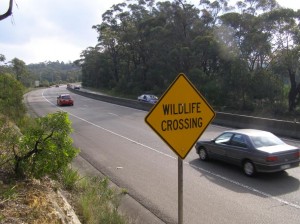
‘Wildlife Crossing sign’, Boddington Hill
Photo by Editor, 20100327
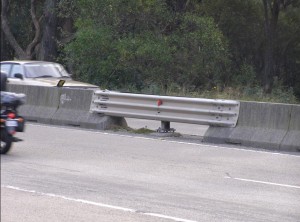 Actual wildlife crossing provided by the RTA
Photo by Editor, 20100327
Actual wildlife crossing provided by the RTA
Photo by Editor, 20100327
Scientifically Recorded species of the Upper Blue Mountains:
Short-Beaked Echidna ( Tachyglossus aculeatus )
Tiger Quoll (Dasyrus maculatus)
Brown Antechinus ( Antechinus stuartii )
Dusky Antechinus ( Antechinus swainsonii )
Common Ringtail Possum ( Pseudocheinus peregrinus )
Common Brushtail Possum ( Trichosurus vulpecula )
Swamp Wallaby ( Wallabia bicolour )
Grey Headed Flying Fox ( Pteropus poliocephalus )
Bush Rat ( Rattus Fuscipes)
Swamp Rat (Rattus lutreolus)
Garden Skink (Lampropholis guichenoti)
Blue Mountains Water Skink (Eulamprus leuraensis)
Eastern Water Skink (Eulamprus quoyii)
Blotched Blue Tongue (Tiliqua nigrolutea)
Pink –Tongued Lizard ( Hemisphaeriodon gerardii)
Weasel Skink ( Saproscencus musteline)
Copperhead ( Austrelaps superbus )
Eastern Brown Snake ( Pseudonaja textiles )
Red – Bellied Black Snake ( Pseudechis porphyriacus)
Common Eastern Froglet ( Crinia signifera )
Striped Marsh Frog ( Lymnodynastes peronii )
[Source: Extract from FAUNA OF THE GULLY, Upper Kedumba River Catchment, Les Peto 2007].
Sightings of these species are so rare these days as to almost, sadly, presume that many have been forced into local extinction by colonist Australians and their descendants and subsequent immigrants.
On 20th December 2010, a local reader sent in the following photographs of the same ‘wildlife crossing’ site where a wallaby had been killed. Many motorists use the derogatory term ‘roadkill’, but this reader certainly conveyed a higher respect for our wildlife. The reader contributed the following personal account with the photos:
.
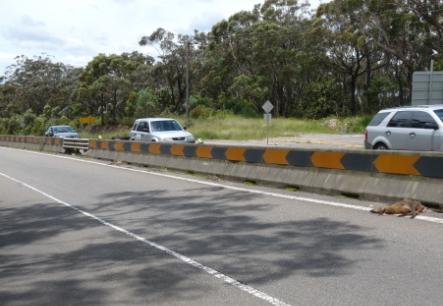
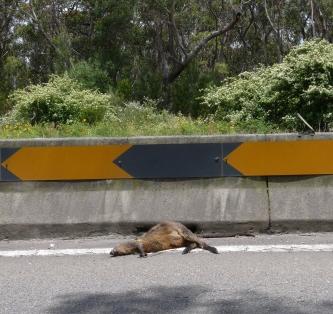
“It shows a swamp wallaby roadkill less than ten metres from the so-called ‘wildlife crossing‘. The carcass has been there for a few days – as a mountains resident you have probably already seen it for yourself.
I too have been wanting to take a photo of the site for the last few years and was prompted to do so after the events of yesterday. I was heading down the highway on my way to work in the morning when I spotted the wallaby on the road. This was the first time in the four years I’ve been living in the mountains that I have seen any significant roadkill at the site, and I felt sickened as I have always considered the wildlife crossing an absolute joke, but now it’s become deadly serious. Further, only two minutes after I saw the wallaby, I came across an injured sulfur-crested cockatoo in the middle of the highway at Bullaburra. After wrapping it up in a jumper, I got my partner to come down from our home in Wentworth Falls to retrieve it, and it subsequently died just before reaching the local WIRES volunteer’s home.
Yesterday’s events have inspired me to address the issue of the complete lack of any facilitation of wildlife movement across the highway – a huge barrier separating the northern and southern sections of the mountains. This has led me to your website – and it is heartening to know that there are plenty of others out there who are also disturbed by the status quo. “
.
© The Habitat Advocate Public Domain
Monday, March 22nd, 2010
 Possibly the last Tasmanian Tigers [Thylacinus cynocephalus]
in Hobart Zoo 1928.
http://www.naturalworlds.org/thylacine Possibly the last Tasmanian Tigers [Thylacinus cynocephalus]
in Hobart Zoo 1928.
http://www.naturalworlds.org/thylacine
.
Any species (carnivorous or herbivorous) that was perceived as an obstruction to man’s so called “progress” was killed through either direct assault by shooting, trapping and laying poisoned baits, or by simply obliterating its habitat.
The thylacine is a classic victim of greed, false notions, irrational opposition toward native wildlife and apathetic attitudes. Thousands of these magnificent animals were killed by Tasmania’s farming community in a misguided attempt to protect alien livestock such as sheep that didn’t belong on the island in the first place.
When compared to other factors, it is unlikely that many domestic animals were actually taken by thylacines. For example, historical records show that the majority of sheep losses were in reality attributable to thieves and predation by feral domestic dogs. Indeed, loss of stock due to thylacines was probably never substantial enough to be economically significant.
In the case of Tasmania, it was unfortunately the thylacine which became the settlers’ target of blame for agricultural troubles. As has so often been the case, a wild, misunderstood species was accused of “getting in the way of development”.
Presented on the Natural Worlds website “is a gallery of twelve historical photographs which date from the late 18th to early 19th centuries. They are a poignant visual record of one of man’s most hurtful actions toward his marsupial cousins. The scenes depicted in this gallery are highly unpleasant, but they should not be forgotten.
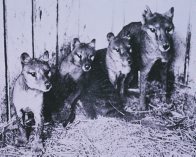 Adult Thylacine with young
© Australian Museum
http://australianmuseum.net.au/image/Adult-Thylacine-with-young/ Adult Thylacine with young
© Australian Museum
http://australianmuseum.net.au/image/Adult-Thylacine-with-young/
.
The persecution of the Thylacine is not just a terrible blight on Australian history, but indeed, that of the world at large. Like all species, this animal is a part of the natural heritage of the planet as a whole – the product of millions of years of evolution. Places which still retain populations of other endangered species would be well advised not to let a similar tragedy befall them.” [Source: C. Campbell’s Natural Worlds 2006, www.naturalworlds.org/thylacine]
.
.
‘Kumanjayi Tiger’
.
Aboriginal Australians hold a cultural taboo against seeing images of the deceased.
Central Australian Aboriginal peoples have traditionally used the term “Kumanjayi” to precede the name of a deceased person.
Did Australian Aboriginal peoples ever force the extinction of a species? Probably not. So the British word ‘extinction’ may probably not have an equivalent term amongst the Australian Aboriginal languages making up over 400 distinct nations that existed across Australia before the 1788 Australian Invasion.
Colonial Australians, dominated by the British, have forced the extinction of many species endemic to Australia, notably and distressingly, the Tasmanian Tiger. Cameron Campbell on his website www.naturalworlds.org provides a rare collection of historical images of the now extinct Tasmanian Tiger. This extinction is one of the most avoidable in history and so or the more tragic and condemning of colonial Australia’s culture. Campbell’s images and old videos convey a magnificently healthy top order predator fine-tuned through eons of Darwinian evolution to survive and thrive in Tasmania’s harsh wild country.
But colonist culture of the time treated the tiger misguidedly like vermin and so in primitive eyes despised it, hunted it, skinned it and ultimately exterminated it from the planet.
Australia is a unique and special island-continent and out of respect for our country, we should start respecting its natural values and embrace its traditional cultures. All of Australia’s natural fauna and flora are endemic: that is, they exist nowhere else on the planet. So how can we as supreme custodians chose to neglect, exploit and destroy this privileged closenessto such uniqueness?
With our knowledge of the existence values and of the human threats to native species, we must stop in our tracks to save the remaining species and their habitat before they are gone.
This website respects the prominence of local Aboriginal rites and advocates a name change of the Tasmanian Tiger to ‘Kumanjayi Tiger’. Should we be able to see images of it without feeling a strong sense of cultural taboo by actively persecuted to extinction? The tiger lives on now only in myth as Australia’s own proud, vibrant, healthy and uniquely Australian top order species.
If any man admires his dog, this was a magnificently wild native dog like no other.
That we killed it to extinction is an abomination.
.
© The Habitat Advocate Public Domain
|
|











 Actual wildlife crossing provided by the RTA
Photo by Editor, 20100327
Actual wildlife crossing provided by the RTA
Photo by Editor, 20100327












